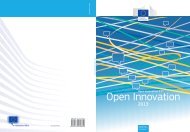How Teachers Are Using Technology at Home and in ... - Prisa Digital
How Teachers Are Using Technology at Home and in ... - Prisa Digital
How Teachers Are Using Technology at Home and in ... - Prisa Digital
Create successful ePaper yourself
Turn your PDF publications into a flip-book with our unique Google optimized e-Paper software.
narrow<strong>in</strong>g or widen<strong>in</strong>g the gap between the most <strong>and</strong> least academically successful students, 44% say<br />
technology is narrow<strong>in</strong>g the gap <strong>and</strong> 56% say it is widen<strong>in</strong>g the gap.<br />
AP <strong>and</strong> NWP teachers are concerned about a digital divide across schools, but<br />
many also say th<strong>at</strong> technology has “narrowed the gap” between the most <strong>and</strong><br />
least academically successful students<br />
Do you agree or disagree with the follow<strong>in</strong>g st<strong>at</strong>ement…Today’s digital technologies are lead<strong>in</strong>g to gre<strong>at</strong>er<br />
disparities between affluent <strong>and</strong> disadvantaged schools <strong>and</strong> school districts?<br />
Strongly agree Somewh<strong>at</strong> agree Somewh<strong>at</strong> disagree Strongly disagree<br />
39% 45% 13% 3%<br />
<strong>Are</strong> today’s digital technologies [lead<strong>in</strong>g to gre<strong>at</strong>er disparity/narrow<strong>in</strong>g the gap] between the most <strong>and</strong> least<br />
academically successful students?<br />
Lead<strong>in</strong>g to gre<strong>at</strong>er<br />
disparity<br />
56%<br />
Narrow<strong>in</strong>g<br />
the gap<br />
44%<br />
Source: Teacher d<strong>at</strong>a from the Pew Research Center's Internet & American Life Project Onl<strong>in</strong>e Survey of <strong>Teachers</strong>,<br />
March 7 to April 23, 2012, n=2,462 middle <strong>and</strong> high school teachers.<br />
AP <strong>and</strong> NWP teachers’ views of disparities between more affluent <strong>and</strong> disadvantaged school districts do<br />
not vary notably across different types of communities. Asked whether they agree or disagree th<strong>at</strong><br />
today’s digital technologies are lead<strong>in</strong>g to gre<strong>at</strong>er disparities between affluent <strong>and</strong> disadvantaged<br />
schools <strong>and</strong> school districts, between 38% <strong>and</strong> 41% of teachers <strong>in</strong> all community types (urban, suburban,<br />
rural <strong>and</strong> small town) “strongly agree” this is the case.<br />
<strong>How</strong>ever, differences on this question do emerge when look<strong>in</strong>g <strong>at</strong> the socioeconomic st<strong>at</strong>us of the<br />
students <strong>in</strong> their classes. While teachers of the lowest (44%) <strong>and</strong> the highest (43%) <strong>in</strong>come students are<br />
equally likely to say th<strong>at</strong> digital tools are lead<strong>in</strong>g to gre<strong>at</strong>er disparity across schools, fewer teachers of<br />
p e w<strong>in</strong>ter n e t .o r g 45
















